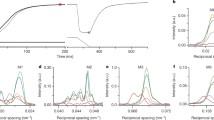Abstract
The myosin-containing A-filaments of vertebrate skeletal muscle contain 294 myosin molecules packed to give overall 3-fold rotational symmetry, as illustrated by the fraying of the filament into 3 sub-filaments (Maw and Rowe, 1980). Further studies on slightly frayed filaments are consistent with a highly linear arrangement of these sub-filaments, at least in the major part of the cross-bridge region where sub-filaments can be observed. Isolated filaments have an unusual hydrodynamic property in the form of an anomalous frictional increment. This property is as yet unexplained; it may possibly be related to flow-induced cyclic movements in the myosin heads.
Self-assembly of A-filaments in vitro to correct length and width has yet to be achieved. We have found however that under certain exactly defined conditions a very accurate reconstruction of both filaments and A-band can be accomplished in situ. Solubilisation of the myosin in chloride-free medium and maintenance of a high local myosin concentration are absolute requirements. Reconstruction is either abolished or modified by preglycerolation or at longer sarcomere length. It is argued that these results suggest a role for the actin filament lattice in myosin assembly, and imply that myosin assembly in the M-line region may be separable from myosin assembly in the cross-bridge region.
Access this chapter
Tax calculation will be finalised at checkout
Purchases are for personal use only
Preview
Unable to display preview. Download preview PDF.
Similar content being viewed by others
References
Davis, J.S., Buck, J. and Greene, E.P. (1982). The myosin dimer: an intermediate in the self-assembly of the thick filament of vertebrate skeletal muscle. FEBS Letters 140: 293–297.
Emes, C.H. and Rowe, A.J. (1978a). Frictional properties and molecular weight of native and synthetic myosin filaments from vertebrate skeletal muscle. Biochim. Biophys. Acta 537: 125–144.
Emes, C.H. and Rowe, A.J. (1978b). Hydrodynamic studies on the self-association of vertebrate skeletal muscle myosin. Biochim. Biophys. Acta 537: 110–124.
Godfrey, J.E. and Harrington, W.F. (1970). Self-association in the myosin system at high ionic strength. I. Sensitivity of the interaction to pH and ionic environment. Biochemistry 9: 886–893.
Herbert, T.J. and Carlson, F.D. (1971). Spectroscopic study of the self-association of myosin. Biopolymers 10: 2231–2252.
Hotani, H. (1982). Micro-video study of moving bacterial flagellai-filaments. III. Cyclic transformation induced by mechanical force. J. Molec. Biol. 156: 791–806.
Huxley, H.E. and Brown, W. (1967). The low-angle X-ray diagram of vertebrate striated muscle and its behaviour during contraction and rigor. J. Molec. Biol. 30: 383–434.
Huxley, H.E., Simmons, R.M., Tarvgi, A.R., Kress, M., Bordas, J. and Koch, M.H.J. Millisecond time-resolved changes in X-ray reflections from contracting muscle during rapid mechanical transients, recorded using synchrotron radiation. Proc. Natl. Acad. Sci. (U.S.A.) 78: 2297–2301.
Lamvik, M.K. (1978). Muscle thick filament mass measured by electron scattering. J. Molec. Biol. 122: 55–68.
Luther, P.K. and Squire, J.M. (1978). Three-dimensional structure of the vertebrate muscle M-region. J. Moles. Biol. 125: 313–324.
Maw, M.C. (1982). A filaments: Structure and reconstruction. Ph.D. Thesis (Leicester).
Maw, M.C. and Rowe, A.J. (1979). Reconstruction of the A-band and A-filaments of rabbit psoas muscle after dissolution in high ionic strength solution. J. Ultrastruct. Res. 69: 142–143.
Maw, M.C. and Rowe, A.J. (1980). Fraying of A-filaments into three sub-filaments. Nature 286: 412–414.
Mihalyi, E. and Rowe, A.J. (1965). Studies on the extraction of actomyosin from rabbit muscle. Biochem. Z. 345: 267–285.
Morimoto, K. and Harrington, W.F. (1974). Substructure of the thick filament of vertebrate striated muscle. J. Molec. Biol. 83: 83–97.
Pepe, F.A. (1967). The myosin filament I. Structural organisation from antibody staining observed in electron microscopy. J. Molec. Biol. 27: 203–225.
Pepe, F.A., Ashton, F.T. and Dowben, P. (1981). The myosin filament VII. Changes in internal structure along the length of the filament. J. Molec. Biol. 145: 421–440.
Reedy, M.K., Holmes, K.C. and Tregear, R.T. (1965). Induced changes in orientation of the cross-bridges of glycerinated insect flight muscle. Nature 207: 1276–1280.
Reedy, M.K., Leonard, K.R., freeman, R. and Arod, T. (1981). Thick myofilament mass determination by electron scattering measurements with the scanning transmission electron microscope. J. Musc. Res. Cell. Motil. 2: 45–84.
Squire, J.M. (1973). General model of myosin filament structure M. Molecular packing arrangements in myosin filaments. J. Molec. Biol. 77: 291–323.
Squire, J.M. (1981). The Structural Basis of Muscular Contraction Plenum, New York and London.
Squire, J.M. and Hayford, J.J. (1982). Fine structure of the A-band in cryosections III. Cross-bridge distribution and the axial structure of the human C-zone. J. Molec. Biol. 155: 487494.
Trinick, J.A. (1973). A-filaments from rabbit skeletal muscle. Ph.D_ Thesis (Leicester).
Trinick, S.A. (1981). End-filaments: A new structural element of vertebrate skeletal muscle thick filaments J Molec. Biol. 151: 151–156.
Trinick, J.A. and Elliott, A. (1982). Electron microscopy of myosin filaments. J. Microscopy 126: 151–156.
Author information
Authors and Affiliations
Editor information
Editors and Affiliations
Rights and permissions
Copyright information
© 1984 Plenum Press, New York
About this chapter
Cite this chapter
Rowe, A.J., Maw, M.C. (1984). Symmetry and Self-Assembly in Vertebrate A-Filaments. In: Pollack, G.H., Sugi, H. (eds) Contractile Mechanisms in Muscle. Advances in Experimental Medicine and Biology, vol 37. Springer, Boston, MA. https://doi.org/10.1007/978-1-4684-4703-3_2
Download citation
DOI: https://doi.org/10.1007/978-1-4684-4703-3_2
Publisher Name: Springer, Boston, MA
Print ISBN: 978-1-4684-4705-7
Online ISBN: 978-1-4684-4703-3
eBook Packages: Springer Book Archive




